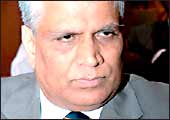 |
| Nothing new, we are #1
again: HDFC Bank has been consistent in its performance
over the past few years |
The winning habit is often contagious,
and none illustrates that better than HDFC Bank. For the fourth
year in a row, the Mumbai-headquartered private sector bank has
been adjudicated the best bank in the 13th Business Today-KPMG study
on India's best banks. In a year in which the survey has been modified,
to include in addition to an analysis of the performance for the
last financial year, a report card for the past three years, HDFC
has been able to regain the numero uno position. This would mean
that the bank is also being recognised for its consistency of performance
over a specific period of time.
In the 2006 sweepstakes, HDFC Bank has edged out arch-rival
ICICI Bank in the overall rankings. More specifically, it's come
up trumps on various parameters, which include return on assets,
return on capital employed, fee income growth, net non-performing
assets (NPAs) and the ratio of net interest income to average
working capital funds. But it isn't as if ICICI Bank has been
blanked out by HDFC Bank. For its part, the bank headed by K.V.
Kamath is top dog on parameters like deposit growth, advances
growth, operating profit growth, capital adequacy ratio and operating
profit per branch. Small wonder then that ICICI Bank has seen
a major jump in ranking, from 13th position in 2005 to the #2
position in the most recent study. Best of all, ICICI Bank, which
is the country's second largest bank after the state-owned State
Bank of India, has come out as the fastest growing bank in the
BT-KPMG survey. Clearly, if ICICI Bank has been judged the fastest
growing bank, it's being rewarded for its steadfast and aggressive
focus on size and volumes. This is amply reflected in the bank's
uncompromising and relentless forays into international and rural
markets, even as it seeks to tighten its grip on the lucrative
urban segment, where an ever-increasing prospering and consuming
class is ensuring that the retail banking engine keeps chugging
along smoothly (at least, so far).
 |
| ABN AMRO has tumbled from #3 to
#16, but Country Representative Romesh Sobti would be happy
with his bank's low net NPA to advances |
For most observers of the banking industry, having HDFC Bank
and ICICI Bank amongst the top 2 wouldn't come as a surprise,
although it can be debated till the cows come home about which
bank should have coveted the #1 position. But there were some
surprises lower down the list. For instance, Standard Chartered
Bank, the largest foreign bank in terms of balance sheet as well
as net profit in India, has improved its rating in a big way,
from #8 last year to #3, while its competitors in the foreign
banking space, Citibank, HSBC and ABN Amro, have seen their ranking
going down in the most recent study. Standard Chartered Bank's
Indian arm contributes almost 10 per cent to the global operations
of the bank. In the last five years, the bank's balance sheet
size has swelled from Rs 20,260 crore to Rs 48,182 crore. Today,
if one judges a bank purely on returns on assets or growth and
productivity, then StanChart will emerge as the best bank in the
country. Standard Chartered Bank today has a network of 81 branches,
16,228 employees and an investment of $1.5 billion (Rs 6,750 crore)
in India.
Amongst the PSU pack, the South India-based Corporation Bank
is the highest-ranked state-owned bank, at #6, relegating the
biggies like State Bank, Bank of Baroda and Bank of India lower
down in double digits. Corporation Bank has scored well on parameters
like net NPAs, cost-to-income ratio and return on assets.
Winner Takes it All
On the asset quality front, it's ABN Amro Bank that has grabbed
the top slot, courtesy its lowest net NPA to advances figure of
0.11 percent. HDFC Bank has a net NPA to advances number of 0.44
per cent. At a time when the financial services sector has seen
a major churning of employees, all the four foreign banks are
clear winners in terms of productivity per employee with the top
four places being occupied by Citibank, Standard Chartered Bank,
HSBC and ABN Amro, in that order. Citibank has got the highest
operating profit per employee, with the figure standing at Rs
0.49 crore.
Capital is yet another tool which, if used efficiently, can
result in higher returns for shareholders. The public sector Indian
Overseas Bank has got the highest return on capital employed at
27.23 per cent followed by Allahabad Bank at 23.67 per cent.
With credit growth outpacing the deposit growth, IDBI Bank,
though with a small base of deposits, has seen the highest cumulative
average growth of 60.86 per cent over two years of its total deposits.
The other top gainers include ICICI Bank, ABN Amro, UTI Bank and
HDFC Bank.
| MOST PRODUCTIVE
|
| RANK BANK OPERATING PROFIT/EMPLOYEES
|
1 Citibank NA 0.49
2 Standard Chartered Bank 0.32
3 HSBC 0.26
4 ABN Amro 0.19
5 ICICI Bank 0.18
Figures in Rs crore |
Fall from Grace
 |
| Citibank's Country Head Sanjay
Nayar has done well to ensure the top slot for his bank on
the productivity per employee front |
Interestingly, there are some banks that have shown a dismal
performance, which is reflected in a plunge in ranking. Those
who have slipped down the pole include Vijaya Bank, State Bank
of Patiala, Andhra Bank, and Punjab National Bank.
Vijaya Bank has fared poorly on return on capital employed,
which languishes at 7.79 per cent as against the #1 bank within
this parameter, Indian Overseas Bank, whose ROCE is an impressive
27.23 per cent. Vijaya's fee to total income was at 7.75per cent
and return on assets (ROA) the lowest at 0.40 per cent. Those
sitting at the bottom of the study include Bank of Maharashtra,
Central Bank, UCO Bank, State Bank of Bikaner and Dena Bank.
Starting this year, the BT-KPMG study has started a new category
to reward smaller sized banks with a balance sheet size of less
than Rs 20,000 crore but with more than 10 branches. State Bank
of Mysore has emerged as the best bank within this club followed
by Kotak Bank and Karur Vysya Bank. In fact, many old private
sector banks figure at the bottom in terms of ranking due to their
sagging financials. These are Bharat Overseas Bank, Catholic Syrian
Bank, Ratnakar Bank, Bank of Rajasthan and Development Credit
Bank. These banks have plenty of catching up to do, what with
the banking industry getting extremely competitive. Many of them
will have little option but to merge or be acquired by a stronger
entity.
BT-KPMG has ranked Centurion Bank of Punjab as the fastest growing
bank amongst those with a balance sheet size of less than Rs 20,000
crore, but with more than 10 branches. Rana Talwar's Centurion
Bank of Punjab has witnessed a turnaround post change of management.
This new generation private sector bank is already in growth mode
with two acquisitions-Bank of Punjab in 2005 and Lord Krishna
Bank in 2006-in the last two years. Talwar, who played a part
in the global merger of Standard Chartered Bank and Grindlays
in 2000, is aggressively eyeing inorganic growth back home.
In the category of banks with a balance sheet size of less than
Rs 20,000 crore, but with a branch network of less than 10, it's
many of the second-rung foreign banks that feature. Barclays Bank
has been ranked number one followed by JP Morgan Chase and Bank
of America. In the past, Barclays Bank has been quite active in
the capital market arena in India. Now it's shifting focus to
commercial banking. The bank has roped in Samir Bhatia, formerly
Country Head (Corporate Banking) at HDFC Bank, as its Chief. Don't
be surprised to see Barclays winning awards in other categories
in the years to come.
 |
| IDBI Bank, with V.P. Shetty at
the helm as Chairman & Managing Director, has registered
the highest deposit growth over two years |
The winning habit is often contagious, and none
illustrates that better than HDFC Bank. For the fourth year in
a row, the Mumbai-headquartered private sector bank has been adjudicated
the best bank in the 13th Business Today-KPMG study on India's
best banks. In a year in which the survey has been modified, to
include in addition to an analysis of the performance for the
last financial year, a report card for the past three years, HDFC
has been able to regain the numero uno position. This would mean
that the bank is also being recognised for its consistency of
performance over a specific period of time.
In the 2006 sweepstakes, HDFC Bank has edged out arch-rival
ICICI Bank in the overall rankings. More specifically, it's come
up trumps on various parameters, which include return on assets,
return on capital employed, fee income growth, net non-performing
assets (NPAs) and the ratio of net interest income to average
working capital funds. But it isn't as if ICICI Bank has been
blanked out by HDFC Bank. For its part, the bank headed by K.V.
Kamath is top dog on parameters like deposit growth, advances
growth, operating profit growth, capital adequacy ratio and operating
profit per branch. Small wonder then that ICICI Bank has seen
a major jump in ranking, from 13th position in 2005 to the #2
position in the most recent study. Best of all, ICICI Bank, which
is the country's second largest bank after the state-owned State
Bank of India, has come out as the fastest growing bank in the
BT-KPMG survey. Clearly, if ICICI Bank has been judged the fastest
growing bank, it's being rewarded for its steadfast and aggressive
focus on size and volumes. This is amply reflected in the bank's
uncompromising and relentless forays into international and rural
markets, even as it seeks to tighten its grip on the lucrative
urban segment, where an ever-increasing prospering and consuming
class is ensuring that the retail banking engine keeps chugging
along smoothly (at least, so far).
For most observers of the banking industry, having HDFC Bank
and ICICI Bank amongst the top 2 wouldn't come as a surprise,
although it can be debated till the cows come home about which
bank should have coveted the #1 position. But there were some
surprises lower down the list. For instance, Standard Chartered
Bank, the largest foreign bank in terms of balance sheet as well
as net profit in India, has improved its rating in a big way,
from #8 last year to #3, while its competitors in the foreign
banking space, Citibank, HSBC and ABN Amro, have seen their ranking
going down in the most recent study. Standard Chartered Bank's
Indian arm contributes almost 10 per cent to the global operations
of the bank. In the last five years, the bank's balance sheet
size has swelled from Rs 20,260 crore to Rs 48,182 crore. Today,
if one judges a bank purely on returns on assets or growth and
productivity, then StanChart will emerge as the best bank in the
country. Standard Chartered Bank today has a network of 81 branches,
16,228 employees and an investment of $1.5 billion (Rs 6,750 crore)
in India.
Amongst the PSU pack, the South India-based Corporation Bank
is the highest-ranked state-owned bank, at #6, relegating the
biggies like State Bank, Bank of Baroda and Bank of India lower
down in double digits. Corporation Bank has scored well on parameters
like net NPAs, cost-to-income ratio and return on assets.
| BEST ASSET QUALITY
|
| RANK BANK NET NPA TO ADVANCES (%) |
1 ABN Amro 0.11
2 Andhra Bank 0.24
3 Punjab National Bank 0.28
4 Standard Chartered Bank 0.36
5 HDFC Bank 0.44 |
Winner Takes it All
On the asset quality front, it's ABN Amro Bank that has grabbed
the top slot, courtesy its lowest net NPA to advances figure of
0.11 percent. HDFC Bank has a net NPA to advances number of 0.44
per cent. At a time when the financial services sector has seen
a major churning of employees, all the four foreign banks are
clear winners in terms of productivity per employee with the top
four places being occupied by Citibank, Standard Chartered Bank,
HSBC and ABN Amro, in that order. Citibank has got the highest
operating profit per employee, with the figure standing at Rs
0.49 crore.
Capital is yet another tool which, if used efficiently, can
result in higher returns for shareholders. The public sector Indian
Overseas Bank has got the highest return on capital employed at
27.23 per cent followed by Allahabad Bank at 23.67 per cent.
With credit growth outpacing the deposit growth, IDBI Bank,
though with a small base of deposits, has seen the highest cumulative
average growth of 60.86 per cent over two years of its total deposits.
The other top gainers include ICICI Bank, ABN Amro, UTI Bank and
HDFC Bank.
Fall from Grace
Interestingly, there are some banks that have shown a dismal
performance, which is reflected in a plunge in ranking. Those
who have slipped down the pole include Vijaya Bank, State Bank
of Patiala, Andhra Bank, and Punjab National Bank.
Vijaya Bank has fared poorly on return on capital employed,
which languishes at 7.79 per cent as against the #1 bank within
this parameter, Indian Overseas Bank, whose ROCE is an impressive
27.23 per cent. Vijaya's fee to total income was at 7.75per cent
and return on assets (ROA) the lowest at 0.40 per cent. Those
sitting at the bottom of the study include Bank of Maharashtra,
Central Bank, UCO Bank, State Bank of Bikaner and Dena Bank.
| MOST EFFICIENT
USERS OF CAPITAL |
| RANK BANK ROCE (%) |
1 Indian Overseas Bank 27.23
2 Allahabad Bank 23.67
3 Standard Chartered Bank 23.21
4 Federal Bank 22.83
5 State Bank of Hyderabad 22.01
ROCE: Return on capital employed |
Starting this year, the BT-KPMG study has started a new category
to reward smaller sized banks with a balance sheet size of less
than Rs 20,000 crore but with more than 10 branches. State Bank
of Mysore has emerged as the best bank within this club followed
by Kotak Bank and Karur Vysya Bank. In fact, many old private
sector banks figure at the bottom in terms of ranking due to their
sagging financials. These are Bharat Overseas Bank, Catholic Syrian
Bank, Ratnakar Bank, Bank of Rajasthan and Development Credit
Bank. These banks have plenty of catching up to do, what with
the banking industry getting extremely competitive. Many of them
will have little option but to merge or be acquired by a stronger
entity.
| BEST CAPITALISED
BANKS |
| RANK BANK CAPITAL ADEQUACY RATIO |
1 IDBI Bank 14.80 %
2 Andhra Bank 14.00%
3 Corporation Bank 13.92%
4 Federal Bank 13.75%
5 State Bank of Patiala 13.67% |
BT-KPMG has ranked Centurion Bank of Punjab as the fastest growing
bank amongst those with a balance sheet size of less than Rs 20,000
crore, but with more than 10 branches. Rana Talwar's Centurion
Bank of Punjab has witnessed a turnaround post change of management.
This new generation private sector bank is already in growth mode
with two acquisitions-Bank of Punjab in 2005 and Lord Krishna
Bank in 2006-in the last two years. Talwar, who played a part
in the global merger of Standard Chartered Bank and Grindlays
in 2000, is aggressively eyeing inorganic growth back home.
| BEST DEPOSIT
MOBILISERS |
| RANK BANK 2-YR CAGR OF TOTAL DEPOSITS
|
1 IDBI Bank 60.86 %
2 ICICI Bank 55.69%
3 ABN AMRO 42.33%
4 UTI Bank 38.36%
5 HDFC Bank 35.46 % |
In the category of banks with a balance sheet size of less than
Rs 20,000 crore, but with a branch network of less than 10, it's
many of the second-rung foreign banks that feature. Barclays Bank
has been ranked number one followed by JP Morgan Chase and Bank
of America. In the past, Barclays Bank has been quite active in
the capital market arena in India. Now it's shifting focus to
commercial banking. The bank has roped in Samir Bhatia, formerly
Country Head (Corporate Banking) at HDFC Bank, as its Chief. Don't
be surprised to see Barclays winning awards in other categories
in the years to come.
|








